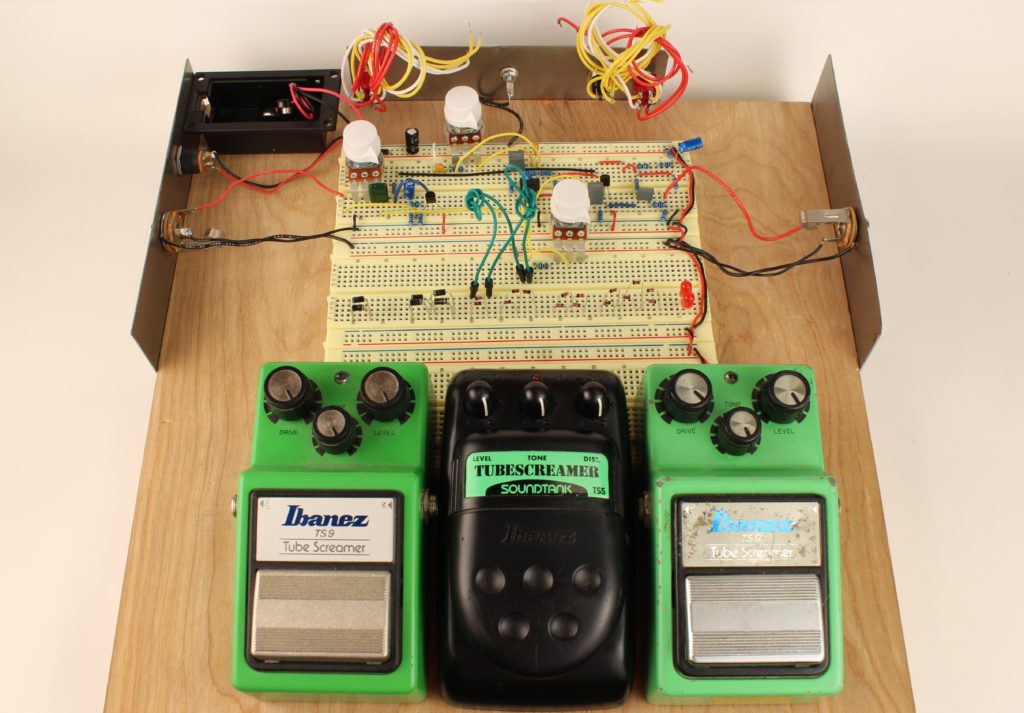Ibanez Tubescreamer Circuit Analysis
Overview – I’m back again with another circuit analysis, this time for the Ibanez Tubescreamer. If you’ve checked out my previous blog post, I did a circuit analysis of the Boss HM-2 Heavy Metal guitar pedal and felt like taking a look at something more common. There are boutique overdrives on the new and used market such as the Klon Centaur, Paul Cochrane Timmy, and Crowther Hot Cake pedal, but what makes the Ibanez Tubescreamer special is that it’s quite abundant and you’ll find one in every guitar shop you visit. Because of this, you’ve probably seen a version of it on the pedalboard of Stevie Ray Vaughn, John Mayer, Kirk Hammett, The Edge, Brad Paisley, and many others. I myself use it as a go-to blues overdrive, or when I want to boost the front end of my Peavey 6505+ in a metal mix. It’s a versatile guitar pedal and recently I’ve been interested in the overall sound and how it works. With that said, let’s dig into it.

In this video, I compare different clipping diodes and see how they react in the Tubescreamer circuit while doing some rhythm guitar playing:
I personally enjoy the stock setup (the two 1N914’s), along with the LED’s. I find the two 1N5819’s to be somewhat interesting. They give a kind of distortion that’s “underneath” the main sound that’s more noticeable in person. Here is a video featuring more lead guitar playing:
I once again enjoy the stock setup (the two 1N914’s), and I also like it without any diodes at all. I feel this gives a very raunchy and in-your-face sound. I can see why many guitar pedal builders have taken the Tubescreamer circuit and modded them in this way. I know there are players who are not that fond of the typical Tubescreamer sound and I think having different clipping options could bring them into the fold.
In this video, I am testing the Tubescreamer circuit that I made on a breadboard against a modern Ibanez TS9, a 1980’s TS9, and a Soundtank TS5:
Conclusion – In my opinion, I think that all of these different guitar pedals sound practically the same with some marginal differences here and there. I think the modern TS9 and the TS5 sound pretty much identical, while the 1980’s TS9 sounds a bit brighter and grittier. I think my breadboard Tubescreamer is somewhere in between. This could be due to a number of factors like components being slightly out of spec for example. I’m inclined to think that the different clipping diodes and their configurations in my breadboard test played much more of a factor in the overall sound than anything else. I’m not someone who puts much stock in differences between op-amps for this circuit. It may lend itself to marginal differences once again, but the circuit design is the most important part of getting the guitar tone you’re after.
As of the time of this post, the prices of these guitar pedals range from less than $50 all the way to $1000 on the used market. If you’re after one, I would suggest not getting hung up on which integrated circuit (chip) it comes with, “magic” or “mojo” components, or which version your guitar hero played. Sonically speaking, there’s very little difference between any of them. I would instead concern myself with the 97% of what it does, as opposed to the 3% of what it does or does not do. With that said, I would also suggest not getting the cheapest available option you can find. If you want an Ibanez Tubescreamer, get one, there’s no need to overthink it.
Thank you for reading and if you have any questions or comments, feel free to message me through the Contact page and I’ll get back to you. Thank you!
-David